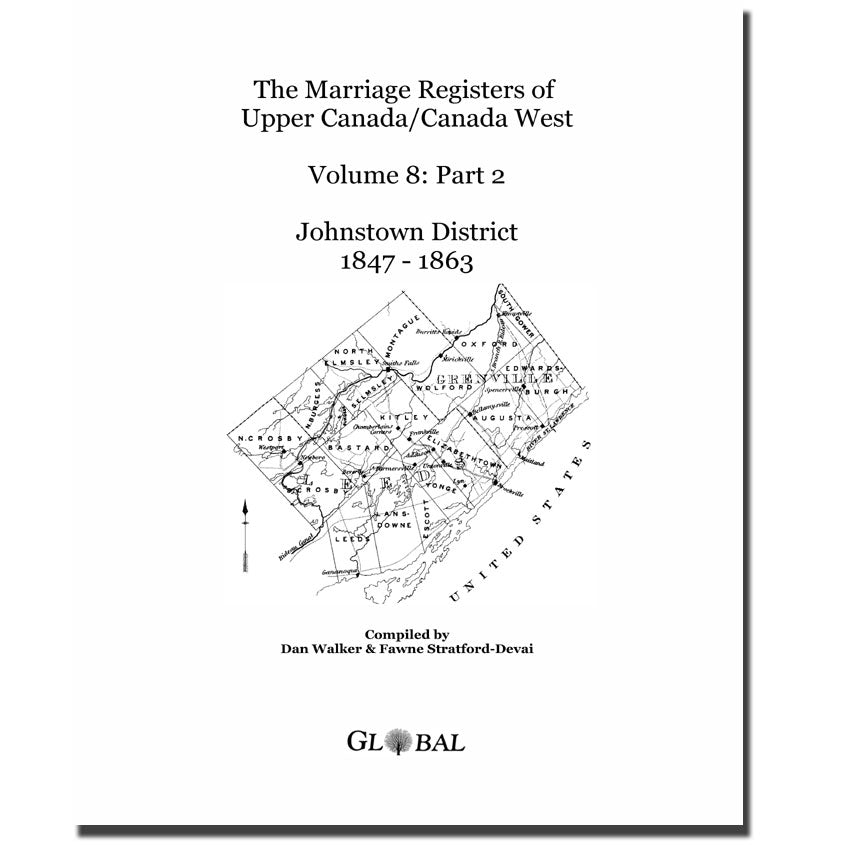Global Heritage Press
Johnstown District Marriage Register of Upper Canada Part 2, 1847-1863
Johnstown District Marriage Register of Upper Canada Part 2, 1847-1863
Couldn't load pickup availability
By Dan Walker & Fawne Stratford-Devai
This work includes a complete transcription of the original Johnstown District Marriage Register and the original marriage returns sent by Ministers to the Clerk of the Peace. Includes all or part of the following contemporary counties: Leeds, Grenville, Carleton & Lanark. NOTE: Contains returns from Ministers which were not included in the Clerk's marriage register even though many of them actually should have been recorded. In addition many returns exist for the period beyond the District Marriage Register (ie. the register only covers the period 1801 - 1851). Returns transcribed in part 2 of this publication date up to 1863.
Townships included in the Johnstown District (townships with an * would become part of the Bathurst District): Bastard, *Bathurst, *Beckwith, *Burgess North, Burgess South, Crosby North, Crosby South, *Dalhousie, *Darling, *Drummond, Edwardsburgh, Elizabethtown, *Elmsley North, Elmsley South, *Fitzroy, *Goulbourn, North Gower (became part of the Dalhousie District), South Gower, Kitley, *Lanark, Landsdown, Leeds, *March, Marlborough (became part of the Dalhousie District), *Montague, *Nepean, Oxford (on the Rideau River), *Ramsay, *Sherbrooke North, *Sherbrooke South, Wolford and Yonge. Surrounding contemporary counties include: Dundas, Frontenac & Renfrew.
With the creation of the Johnstown District, 1st Jan. 1800, marriage returns for the counties of Leeds and Grenville were required to be returned to the Clerk of the Peace in the District town of Brockville. Returns were sent to the Clerk of the Peace from ministers who performed marriages, with the exception of Anglican and Roman Catholic ministers. However, many Anglican and Catholics settlers married in churches of convenience or by passing circuit riders when churches of their own faith had not been established yet -- the result is that many of those marriages appear in these District Marriage Registers.
The Clerk of the Peace then recorded the returns in a register kept in the office. The Register kept by the Clerk in Brockville is what we today refer to as the Johnstown District Marriage Register. Carleton County was originally part of the Johnstown District but in 1831 it became part of the Bathurst District. On the 30 May 1849 the Johnstown District was abolished and the United Counties of Leeds and Grenville succeeded the District.
The Register begins in 1801 with a few affidavits dating back to 1799. For some reason, not all marriage returns from Ministers were included in the Marriage Register kept by the Clerk of the Peace in Brockville. The Register begins in 1801 with a few affidavits dating back to 1799. In May of 1849 the Johnstown District was abolished and the United Counties of Leeds and Grenville succeeded the District. The Clerk continued to record marriages in the Register beyond 1849 and the original marriage returns from clergy exist well beyond the period covered by the Register. The original marriage returns transcribed in part 2 start as early as 1847 and in some instances date as late as 1863 - None of the returns in part 2 were ever recorded in the Clerks Marriage Register!
Check bordering Districts: Complete District Marriage Register Series booklist When searching for marriages recorded in District Marriage Registers keep in mind that many returns were submitted by ministers who were circuit riders who often performed marriages at great distance from their home bases. Circuit riders reported marriages in the register of the District where they lived which was not necessarily in the same District where the marriage took place. That said, if you cannot find the marriage in the Johnstown District register you would be well advised to search bordering districts such as the Eastern, Ottawa, Dalhousie, Bathurst and Midland Districts.
Related article: District Marriage Registers of Upper Canada (Ontario) 1786-1870 - What are they and why are they important?
Details:
199 Pages
8.5" X 11"
Maps
Index
Originally published by Norsim, Toronto, 1995
This revised and updated edition with new maps and introduction published by Global Heritage Press, Milton, 2000
ISBN 978-1-894571-20-3 (coil-bound edition)
Share



